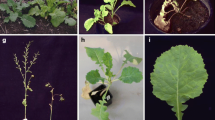Abstract
A potato leafroll virus (PLRV) isolate has been successfully transmitted to and recovered from two wild crucifers,Sisymbrium altissimum L. (Jim Hill or tumble mustard) andCapsella. bursa-pastoris (L.) Medic. (shepherd’s purse) by the green peach aphid (GPA),Myzus persicae (Sulzer). Virus antigen in both plant species was found to be higher in root tissue than in foliar tissue, based on enzyme-linked immunosorbent assay (ELISA) determinations.C. bursa-pastoris was apparently a relatively poorer source of inoculum for the GPA thanS. altissimum. Using two geographically-separated biotypes ofC. bursa-pastoris, a Washington biotype was found to contain higher antigen titer in both leaf and root tissue than a California biotype, as determined by ELISA. Field studies demonstrated that both weed species can serve as overwintering sources of PLRV
Compendio
Un aislamiento del virus del enrollamiento de la hoja de la papa (PLRV) ha sido exitosamente transmitido y recobrado de dos crucífieras silvestres,Sisymbrium altissimum L. (Jim Hill o mostaza postrada)y Capsella bursa-pastoris (L.) Medic, (boisa de pastor) por el áfido verde del melocotonero (GPA),Myzus persicae (Sulzer). Basándose en determinaciones efectuadas con la prueba inmunológica ELISA se encontró que el antígeno del virus en ambas especies vegetales era más alto en los tejidos de las raíces que en los de las hojas.C. bursa-pastoris fue aparentemente una fuente más o menos pobre de inóculo para el GPA, en comparación conS. altissimum. Utilizando dos biotipos geográficamente separados deC. bursa-pastoris, se encontró que un biotipo de Washington tenía, tanto en los tejidos de la hoja como en los de la raíz, una concentratión más alta de antígeno que un biotipo de California, tal como quedó comprobado con la técnica ELISA. Estudios de campo demostraron que ambas malezas pueden servir como fuentes de invernacion del PLRV.
Similar content being viewed by others
Literature Cited
Casper, R. 1977. Detection of potato leafroll virus in potato and Physalis floridana by enzyme-linked immunosorbent assay (ELISA). Phytopathol Z 90:364–368.
Clark, M.F. and A.N. Adams. 1977. Characteristics of the microplate method of enzyme-linked immunosorbent assay for the detection of plant viruses. J Gen Virol 34:475–483.
Davis, E.W. and B.J. Landis. 1951. Life history of the green peach aphid on peach and its relation to the aphid problem on potatoes in Washington. J Econ Entomol 44:586–590.
Duffus, J.E. 1964. Host relationships of beet western yellows virus strains. Phytopathol 54:736–748.
Duncan, D.B. 1955. Multiple range and multiple F tests. Biometrics 11:1–42.
Gunn, L.V. and R.D. Pares. 1988. Effect of potato physiology on the interpretation of ELISA results for potato leafroll virus. Plant Pathology 37:516–521.
Harrison, B.D. 1984. Potato leafroll virus. CMI/AAB Descriptions of Plant Viruses No 291 (No. 36 revised).
Hassan, Sher and P.E. Thomas. 1989. Purification and some properties of yellow top virus. Sarhad J of Agric 5:507–519.
Helson, G.A.H. and D.O. Norris. 1943. Transmission of potato virus diseases. 3. Susceptibility of Cruciferae to potato leaf roll virus. J Counc Sci Ind Res Austral 16:261–262.
Hintze, J.L. 1987. Number Cruncher Statistical System, Version 5.01 Kaysville, Utah.
Peters, D. and R. A.C. Jones. 1981. Potato leafroll virus, p. 68–70In: Compendium of Potato Diseases (W.J. Hooker, Ed.). Am Phytopath Soc, St. Paul, MN., 125 pp.
Quanjer, H.M., H.A.A. Van der Lek and J.O. Botjes. 1916. Aard, Verspreidingswijze en Bestrijding van Phloeemnecrose (Bladrol) en verwante ziekten. Meded Rijks Hoogere Land-, Tuin-Boschbouwshool, Wageningen 10:1–138. (Translated Version)
Simpson, G.W., W.A. Shands and O.L. Wyman. 1945. Weeds and the aphid-leafroll problem in potatoes. Maine Ext Bull No 333, 20 p.
Tamaki, G. 1973. Spring populations of the green peach aphid on peach trees and the role of natural enemies in their control. Environ Entomol 2:186–191.
Thomas, P.E. 1983. Sources and dissemination of potato viruses in the Columbia Basin of the Northwestern United States. Plant Dis 67:744–747.
Author information
Authors and Affiliations
Additional information
Mention of a trademark or proprietary product does not constitute a guarantee or warranty of the product by the USDA and does not imply its approval to the exclusion of other products that may also be suitable. This article reports the results of research only
Rights and permissions
About this article
Cite this article
Fox, L., Biever, K.D., Toba, H.H. et al. Overwintering and monitoring of potato leafroll virus in some wild crucifers. American Potato Journal 70, 505–515 (1993). https://doi.org/10.1007/BF02846751
Accepted:
Issue Date:
DOI: https://doi.org/10.1007/BF02846751




